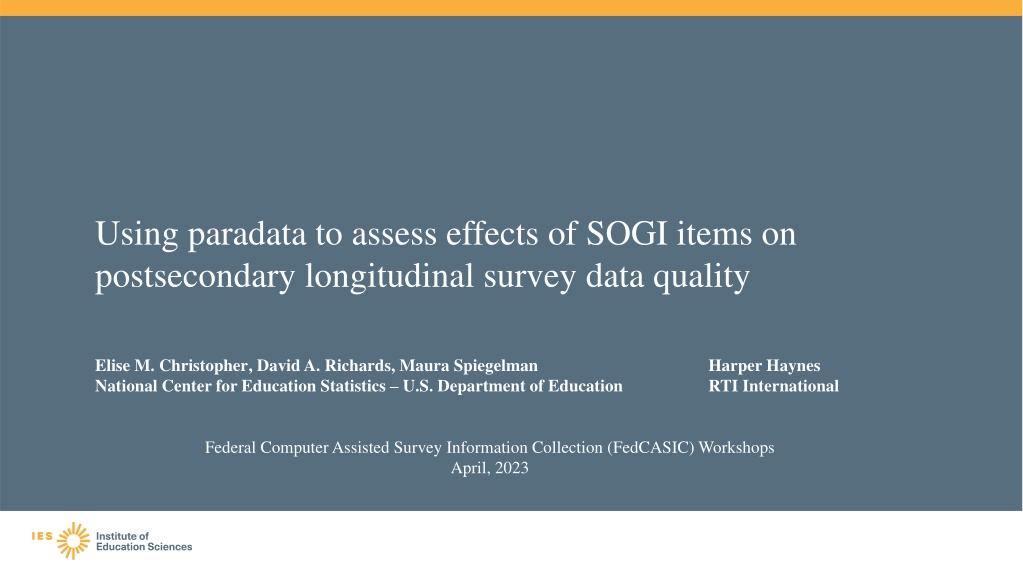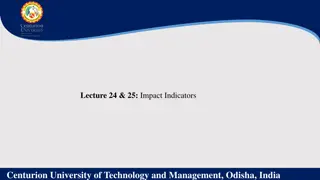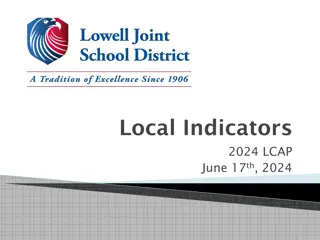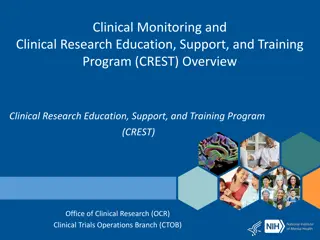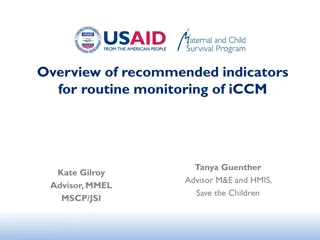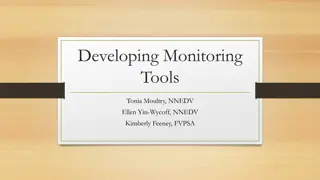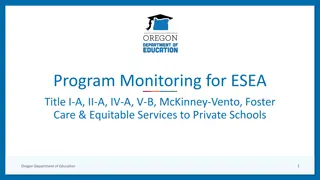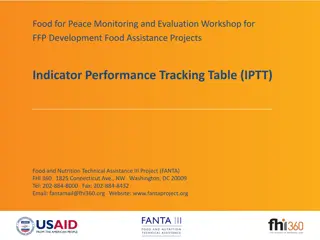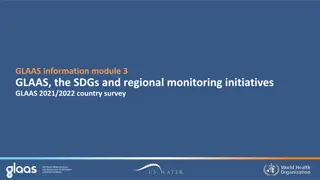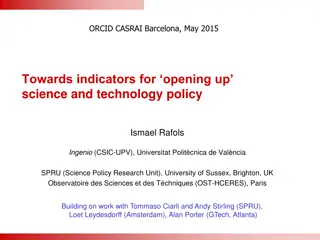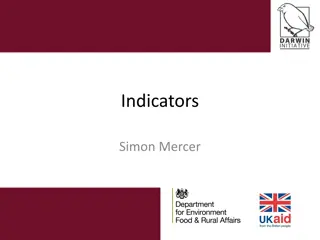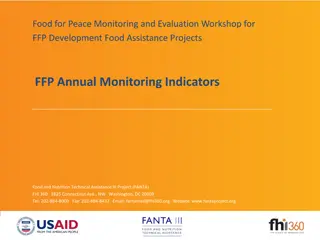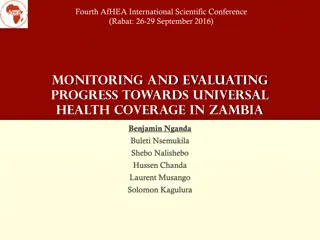Monitoring MDG Indicators in Burundi
The Ministry of Planning in Burundi established a committee in 2006 to monitor MDG indicators, with a focus on employment-to-population ratio. The committee adopted additional indicators, ensuring they are easy to interpret, meet international standards, and have reliable data sources. Metadata availability and content for each indicator are essential in tracking progress towards the Millennium Development Goals.
Download Presentation

Please find below an Image/Link to download the presentation.
The content on the website is provided AS IS for your information and personal use only. It may not be sold, licensed, or shared on other websites without obtaining consent from the author.If you encounter any issues during the download, it is possible that the publisher has removed the file from their server.
You are allowed to download the files provided on this website for personal or commercial use, subject to the condition that they are used lawfully. All files are the property of their respective owners.
The content on the website is provided AS IS for your information and personal use only. It may not be sold, licensed, or shared on other websites without obtaining consent from the author.
E N D
Presentation Transcript
Using paradata to assess effects of SOGI items on postsecondary longitudinal survey data quality Elise M. Christopher, David A. Richards, Maura Spiegelman National Center for Education Statistics U.S. Department of Education Harper Haynes RTI International Federal Computer Assisted Survey Information Collection (FedCASIC) Workshops April, 2023
This presentation is intended to promote ideas. The views expressed are part of ongoing research and do not necessarily reflect the position of the U.S. Department of Education or RTI International. 2
Background In 2012, NCES decided to ask questions about sexual orientation and gender identity (SOGI) due to lack of data on education and labor outcomes for LGBTQ+ populations High School Longitudinal Study of 2009 (HSLS:09) 2019-20 National Postsecondary Student Aid Study (NPSAS:20) Beginning Postsecondary Students Longitudinal Study (BPS:20/22) Baccalaureate and Beyond Longitudinal Study (B&B:08/18; B&B:16/17; B&B:16/20) Fielded from 2016 through present Past evaluation shows HSLS:09 items function as well as other demographic questions (disability, income) with similar or lower rates of breakoffs, item nonresponse, and time per screen (Christopher and Burns 2021) NPSAS and B&B respondents use write-in boxes to provide substantive information (Richards, Christopher, and Spiegelman 2022) Continuing evaluation is critical to monitor item functioning over time and for different populations 4
SOGI questions in NCES secondary surveys Elise Christopher (NCES) and Laura Burns (RTI International) assessed SOGI item performance in HSLS:09 Nationally representative study of 23,000+ 9th-graders, followed throughout high school, into postsecondary education and early careers Second follow-up: 2016 (most were 3 years post-high school, ~20-21 years old), SOGI measures added Findings: Breakoffs: No evidence that these questions make respondents leave the survey Nonresponse: No evidence that these questions are skipped at a higher rate than other sensitive questions Time: No evidence, either from median time on screen OR outliers in time spent on screen, that these questions are burdensome Conclusion: Adding SOGI items in a later wave of HSLS:09 was successful 5
Objective: Assess the functioning of SOGI questions in NCES postsecondary surveys The National Postsecondary Student Aid Study Cross-sectional study of students at all levels of postsecondary education Data collected primarily through web surveys with phone interviews as a secondary method Serves as frame for the Beginning Postsecondary Students Longitudinal Study (BPS) and Baccalaureate and Beyond Longitudinal Study (B&B) Beginning Postsecondary Students Longitudinal Study (BPS) Longitudinal follow-up to NPSAS with first-time postsecondary students Baccalaureate and Beyond Longitudinal Study (B&B) Longitudinal follow-up to NPSAS with Bachelor's degree recipients 6
NCES postsecondary surveys Study name B&B:16/17 Eligibility Earned a BA in 2016 Collection year 2017 Cases n= 28,800 NPSAS:20 Postsecondary student in 2020 2020 n=100,410 BPS:20/22 Began postsecondary education in 2020 2022 n= 37,000 7
Sexual Orientation (SO) and Gender Identity (GI) questions in NCES postsecondary surveys Initial focus group and expert recommendations suggested that gender identity measure should be two-step Sex at birth asked first, then current gender with more than two options Reviewed extant measures not many federal surveys asked GI at time of development, but for SO consulted Youth Risk Behavior Survey (YRBS), National Health Interview Survey (NHIS), National Survey on Family Growth (NSFG) Needed to balance ability for sample members to report identities with minimization of measurement error and burden SOGI questions were added to the demographics section of the surveys beginning in 2016 9
SOGI questions in B&B, NPSAS, and BPS What sex were you assigned at birth (what the doctor put on your birth certificate)? o 1=Male o 2=Female Do you think of yourself as o 1=Lesbian or gay, that is, homosexual o 2=Straight, that is, heterosexual o 3=Bisexual o 4=Another sexual orientation (please describe) o 5=Questioning or unsure (please describe) [B&B] o -1=Don t know (please describe) [NPSAS/BPS] What is your gender? Your gender is how you feel inside and can be the same or different than your biological or birth sex. Male Female Transgender, male-to-female Transgender, female-to-male Genderqueer or gender nonconforming (please describe) A different gender (please describe) Questioning or unsure (please describe) [B&B] 10
Research questions Use of paradata from data collection to examine: Breakoffs: Do respondents leave the survey? Item nonresponse: Do they skip the questions? Time: Do the questions give them pause? How do SOGI questions compare to other "sensitive" demographic items? Do these findings vary across studies? 12
Analysis Metrics compared to Income - a demographic item that typically has high item missingness Disability status a demographic item that is sometimes perceived as sensitive Respondents who Began the questionnaire (even if items were skipped) Had known paradata for all SOGI and comparison items Any differences noted have undergone statistical significance testing using a 95 percent confidence level. 13
Results 14
Breakoff rates (percent) Very low breakoff rates for SOGI, disability, and income items For all three studies, breakoff rates at SOGI items were statistically lower than breakoff rates at questions about income (categorical OR numeric/continuous) For some studies, breakoff rates at SOGI items were lower than breakoff rates at items about disability NPSAS and BPS, comparing gender and disability NPSAS, comparing sexual orientation and disability # rounds to zero 15
Item nonresponse rates (percent) For all three studies, item nonresponse rates were higher for sexual orientation than for disability (though low overall) Item nonresponse rates for sexual orientation were higher than for questions asking income in ranges and lower than for the question asking exact numeric/continuous income Some differences were found across studies for SOGI items Lower item nonresponse rate for gender in B&B:16/17 than NPSAS:20 and BPS:20/22 Lower item nonresponse rate for sexual orientation for B&B:16/17 than other collections; higher for BPS:20/22 than other collections 16
Question timing (median seconds) For all three studies, respondents spent more time with questions about their income (regardless of how it was asked) than with SOGI items For all three studies, respondents spent more time with questions about their SO than disability status (though this difference ranged between .36 and 1.63 seconds) The time spent on SOGI items varied across studies. For each question on sex, gender, and sexual orientation, the time per page was longer for the 2017 study (B&B:16/17) than for the 2020 study (NPSAS:20), and longer for the 2020 study than for the 2022 study (BPS:20/22) 17
Discussion 18
Summary Breakoffs: Item nonresponse: For gender, item nonresponse lower in B&B:16/17 than in NPSAS:20 and BPS:20/22. For SO, higher than disability, but low overall. Item nonresponse lower for B&B:16/17 and higher for BPS:20/22 than other collections. Item nonresponse is relatively low, similar to other sensitive items, with the exception of exact income. Time: Slightly higher for SO than for disability for all three studies. Varied across studies for SOGI items. Time was longer for B&B:16/17 than for NPSAS:20 and longer for NPSAS:20 than for BPS:20/22. Respondents answer SOGI items significantly faster than items on income. Very low for SOGI, disability, and income items. No evidence that these questions make respondents leave the survey. 19
Next steps Continue to evaluate item performance Investigate differences by respondent characteristics and behavior Respondent age, race and ethnicity, and other demographic characteristics Survey mode and device (laptop/desktop computer, mobile device, telephone) Language in which survey was administered (English or Spanish) 20
